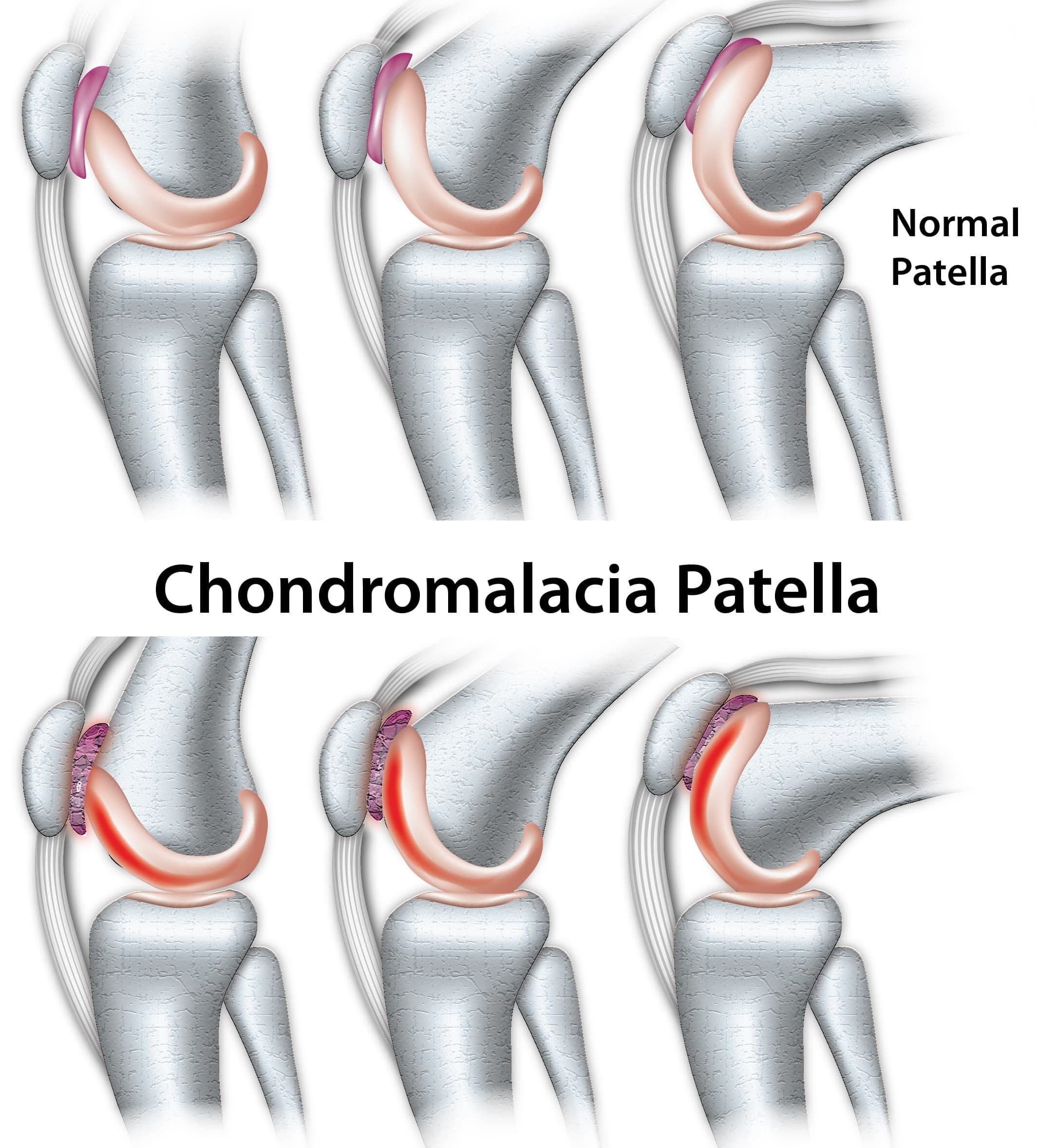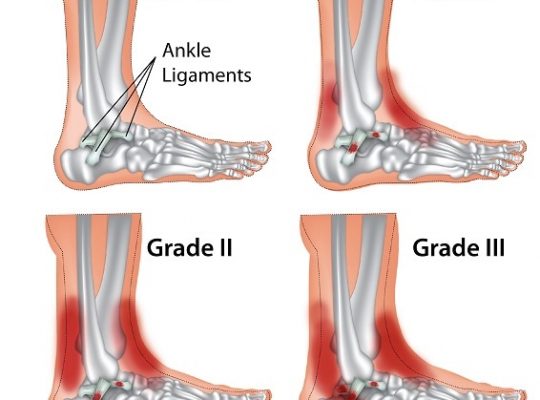Chondromalacia patella (or patellae), also referred to as “runner’s knee” is a condition in which the cartilage cushioning the area under the patella (kneecap) begins to deteriorate and wear out. Due to this, the kneecap may start to rub against the femur (thigh bone) and cause discomfort or pain. This condition is often common among young athletes or sports people do to increased activity and action involving the knees. The condition can also occur in adults who are suffering from arthritis.

Chondromalacia patella can often occur due to misalignment of the knee or as a result of overuse, which can be seen it treated by a few days of rest. In the case of improper knee alignment, resting will not be enough and physiotherapy or surgery may be necessary to correct it.
Causes
Chondromalacia patella is most common in teenagers and young adult, usually affecting women more than it does men. It is not fully known the reason why it occurs, but studies have indicated that when the patella (kneecap) rubs against the femur (thigh bone) this can damage the cartilage underneath the patella, which is necessary for cushioning and reducing friction between the bones and joint. The main causes for this condition are usually:
- Alignment problems with the knee or foot.
- Overuse of the knee
- Wear and tear as part of the aging process
- Arthritis of the knee
- Hypermobile joints
- Imbalance of thigh muscles surrounding the knee
There are also certain risk factors, which increase the likelihood of having “runner’s knee” (chondromalacia patella), these include:
- Age – growth spurts can often lead to imbalances between the bones and muscles
- Flat feet – those with flat feet are more likely to have more pressure placed on the knee
- Prior injury – previous injury to the knee region may increase the risk of runner’s knee
- Gender – women are said to be more likely to develop this condition as they generally have less muscle mass than their male counterpart causing more lateral pressure on the patella.
- High movement – participating in sports that require a high level of movement can increase the wear on the knees and joints increasing the risk of injury.
Symptoms
Individuals suffering from chondromalacia patella will often record similar symptoms to other conditions in the knee. The common symptoms being:
- Pain and swelling around the kneecap
- Clicking or grinding noise when bending or straightening the knee
- Discomfort when walking up or down stairs
- Discomfort when in a seated position for a long duration (it can be sometimes referred to as ‘theatre knee’ or ‘movie-goers knee’)
Diagnosis
A provisional diagnosis of chondromalacia patella is usually made after an examination by a doctor or qualified physiotherapist. It is usually an active diagnosis as it requires further follow ups, due to lack of access to the cartilage. If the initial signs show no proof of damage to the cartilage then the doctor is likely to view the injury as patellofemoral pain syndrome rather than runner’s knees.
Based on the results of the tests there are provided, different levels and of severity that can be experienced.
Grade 1 – softening of the cartilage around the knee
Grade 2 – softened cartilage alongside erosion of the tissue and an uneven surface
Grade 3 – increased deterioration with thinning of the cartilage
Grade 4 – bone exposure and significant deterioration of the cartilage tissue. In this event the bones are likely to be rubbing against each other and surgery may be required
If a diagnosis cannot be gathered from the initial physical examination by the doctor or it is unclear, then further tests may be carried out in certain situations. Tests that may be carried out include:
- X-ray – this alongside standard blood tests can help in ruling out any underlying issues such as inflammation or arthritis
- Arthroscopy – this is usually carried out to provide a direct look into the actual state of the cartilage. In this procedure, a small flexible camera is inserted into a keyhole through the knee
- MRI scan – this provides a more detailed view of the knee and surrounding joints, it is usually the most flexible method of confirming chondromalacia patella.
Treatment
The initial mode of treatment for injuries such as chondromalacia patella after diagnosis is the application of the R.I.C.E principle (Rest, Ice, Compress, and Elevate). Although applying this in itself will not cure chondromalacia patella, it will help in reducing the discomfort, swelling or pain associated with the injury. It is essential to understand and correct the initial cause(s) of the injury and the treatment program that is recommended may be a mixture or one of the following:
Painkillers and anti-inflammatory medication – apart from the application of the RICE principle, the health professional may also recommend the use of NSAIDs and other anti-inflammatory medication which can aid in reducing the pain also.
Physiotherapy – exercises and a range of movement to strengthen the surrounding muscles and joints can help in the rehabilitation of the knee. Improving the lateral quadriceps structure leading to the knee can help in reducing pressure on the knee and cartilage and prevent further injury to the knee.
Patella taping – this treatment form can help to lessen the pain by preventing the rubbing together of the kneecap and the sore spot which causes the pain. The adhesive tapes are placed along either side of the affected knee, helping to guide and correct the movement of the patella. There are two main forms of patella taping techniques including the controlling technique for new injuries and the correct tracking technique for those looking to get back into sports activities. Knee supports specially designed for the patella can also help in relieving pain and pressure.
Surgery – this is usually not common for this kind of injury and only occurs when other treatment methods or rehabilitation have proved to be unsuccessful. The surgical procedure is usually simple and involves the use of an arthroscopy or keyhole surgery, whereby the damaged or deteriorated cartilage is either removed or shaved.
Prevention
To avoid a repeat of chondromalacia patella or to prevent it from occurring in the first instance, the following steps can be followed to prevent the likelihood:
- Wearing the correct footwear can help to improve the arch of the feet, which is particularly useful for those with flat feet. As the pressure on the kneecap is reduced, it may help with the proper alignment of the kneecap.
- Use of knee pads and patella supports, especially during repeated use can help reduce the likelihood of injury.
- Performing regular strengthening exercises can help with muscle balance, especially for the hamstrings, quadriceps, adductors, and abductors.
- Lowering body weight can reduce overall stress and pressure on the knees lowering the risk of chondromalacia patella. Reducing overall calorie intake and eating a balanced diet alongside regular exercising can help in keeping the knees and joints healthy in the long run.






